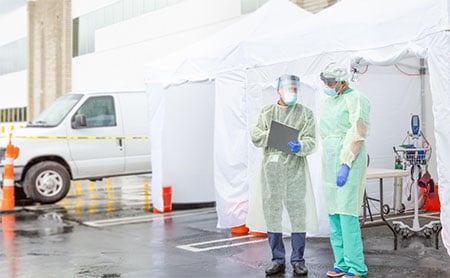How Massachusetts Streamlines Data Sharing to Strengthen Emergency Preparedness
November 06, 2024 | Justin McClain

Time is of the essence when it comes to getting crucial supplies such as personal protective equipment and medical countermeasures (MCMs) out to communities during an emergency. Local, state, and federal partners must work together and have timely access to actionable data to address communities’ needs. State health agencies need to know how many public health supplies are on hand so they can make informed decisions and respond to evolving situations.
In March 2024, ASTHO, with support from the Administration for Strategic Preparedness and Response’s (ASPR) HHS Coordination Operations and Response Element, selected three state health agencies—Ohio, Massachusetts, and Washington—to identify and pilot scalable solutions for enabling bidirectional information sharing regarding ASPR-deployed assets across all levels of public health.
In June 2024, staff from ASTHO’s preparedness team and ASPR traveled to Boston to visit the Massachusetts Department of Public Health (MDPH). While there, MDPH shared that strong support from leadership, along with a charge to enhance the department’s preparedness posture, has been a driving force in moving toward a comprehensive inventory management system and bidirectional data sharing across the state. ASTHO and ASPR staff also learned more about ideas MDPH has for overcoming the complexities encountered while operating within a home-rule state.
351 to One: Tracking and Requesting Resources Across 351 Jurisdictions
As a home-rule state, each of Massachusetts’s 351 municipalities has its own health department or board of health. The sheer number of individual jurisdictions makes for a wide variation in the workforce and operational procedures of each. Having real-time, actionable data on MCMs that are spread between 351 jurisdictions can seem like an insurmountable challenge, but MDPH plans to use a resource already available to connect the data coming from each jurisdiction: their healthcare coalitions.
MDPH has six subregional healthcare coalitions that provide an added layer of resource coordination and information sharing between the jurisdictions and the state. While each coalition may operate in a slightly different way to best address the needs of its region within the state, there is a framework for staffing and functions that must be followed. Included in the framework are minimum data element and data sharing requirements. This framework with standard elements will allow MDPH to implement a standardized, scalable, and flexible MCM data solution and update minimum data elements across the state.
MDPH manages a fast-moving state strategic MCM stockpile and each of the six coalitions have regional stockpiles that serve as an intermediary when jurisdictions request resources. At the start of the pilot site project, MDPH noted inconsistent resource tracking between the stockpiles and a cumbersome resource requesting process that, in some cases, involved filling out and faxing paper forms or reformatting and merging multiple Excel sheets. The over 10.5 million individual items that were shipped from the stockpiles in 2023 highlighted the need for an improved resource requesting process and minimum data elements for tracking resources. MDPH has since updated their minimum data elements, identified an improved inventory management system, and will implement a streamlined resource requesting process to share data in a smoother, more actionable way. The inventory management solution implemented by MDPH allows for statewide public health resource availability in near real time.
A Sustainable Path Forward
Sustainability has been a constant part of the pilot site project for MDPH. They want to make sure that the work being done now will remain in place and lead to stronger responses during future emergencies.
Shane Keville-Wagner, Resource and Inventory Coordinator with MDPH’s Office of Preparedness and Emergency Management, described their sustainability efforts as “not just about the present, but about ensuring that systems we put into place today will continue to strengthen our response capabilities in the face of future public health emergencies. By prioritizing resource efficiency and long-term data management solutions, we aim to build a resilient foundation that will serve the Commonwealth for years to come.” MDPH has done this by including the cost of the inventory management system in future budgets and finding more cost-effective warehousing solutions, such as using barcodes instead of RFIDs to track resources that will stay in one spot for a prolonged period and stacking product pallets to reduce the warehouse footprint.
As MDPH wraps up their pilot site project and charts a sustainable path forward, the necessity of coordinated data sharing across all levels of public health for a strong emergency response remains clear.